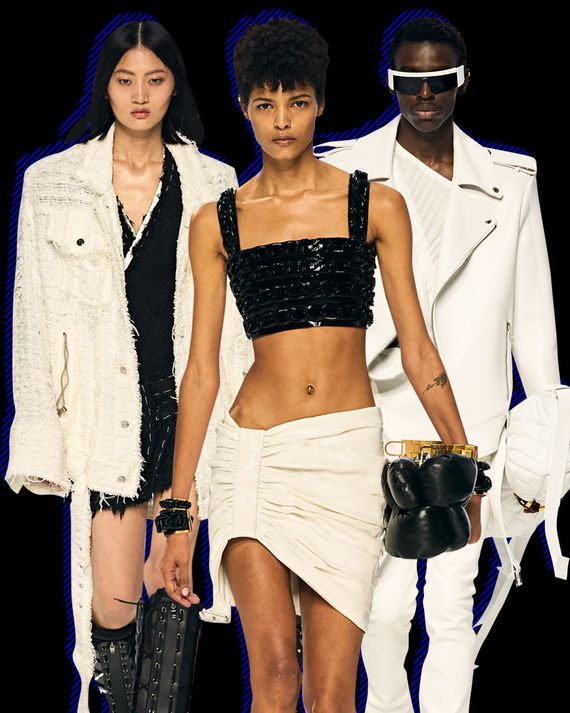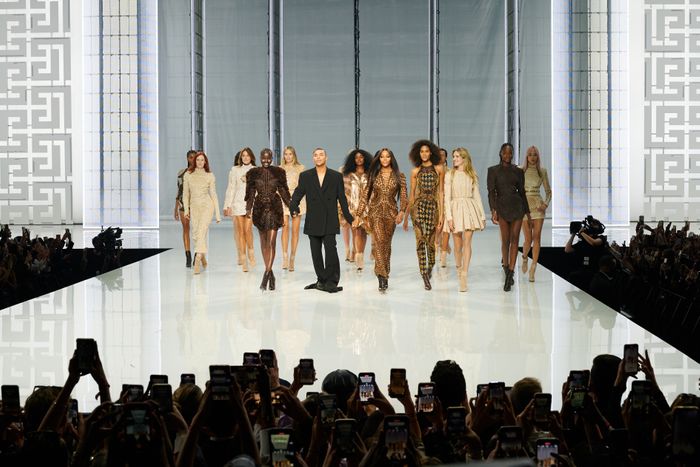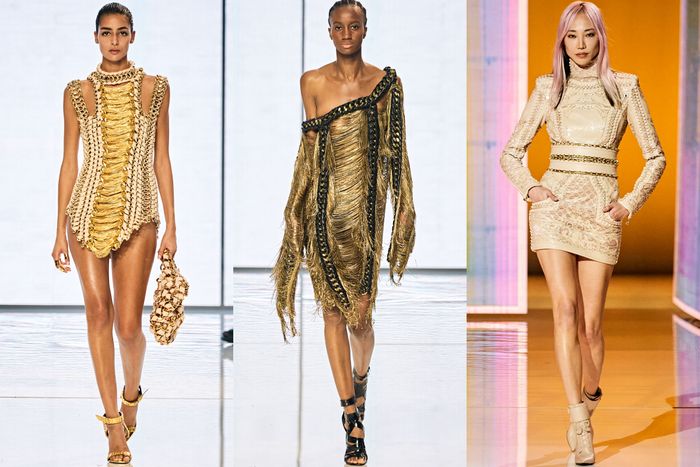
Considering that 6,000 people were waiting in the arena for the Balmain show to begin, Olivier Rousteing was remarkably calm backstage. We were in a Paris suburb on Wednesday night. In honor of Rousteing’s ten years as creative director of the house, Balmain had opened the show and concert to the public, with ticket proceeds going to Bono’s Red charity. People came decked out in their Balmains, a twinkling rave of gold and silver punctuated by black leather and the sci-fi peaked shoulders that Rousteing made a look.
I found Rousteing backstage before the show. This took some navigating — around lines of models, makeup artists ducking in and out with their brushes drawn, electrical cables snaking across the floor, and beefy security guys. But eventually I reached the designer in a small, curtained enclave, where he had photos of every look, roughly 110, displayed on two large boards. Somewhere in the bowels of the arena, presumably in their own enclaves, were the show’s stars, among them Naomi Campbell, Natalia Vodianova, and Carla Bruni, who would appear in finale dresses from Rousteing’s decade at Balmain. Beyoncé was also there but only in spirit, having supplied a prerecorded tribute.
“The collection is a celebration of freedom,” Rousteing, in a black suit, his fingers covered with as many gold rings, said. That probably sounds like rhetoric, but there’s some truth in it. Very early on, when Rousteing, who is 34, replaced Christophe Decarnin, who had succeeded Oscar de la Renta at Balmain, people tried to fit him into a box. Editors had loved Decarnin’s cool rock look. Rousteing’s clothes, by contrast, were part fabulous couture, part audacious streetwear. In short, it was easy to sneer at his over-the-top designs. Plus, Rousteing was talking to a new world: folks on social media. He was one of the first high-fashion designers to launch an Instagram page. He befriended the Kardashians.
In one way or another, Rousteing, who was raised in Bordeaux and adopted from an orphanage at the age of 5 months, pushed through one of the most hidebound institutions in existence, the Paris fashion world. Not every collection worked, to be sure. He had seasons when his intentions seemed muddled, or perhaps we were simply looking away. But as Beyoncé said, accurately, Rousteing kept “pushing for a new mind-set.” With Balmain, he opened the door to different kinds of people, different tastes and body types.
As a show, this celebration was important. There is a difference between a massive show that includes the public and one that uses a public space for a private event, as Dior and LVMH did on Tuesday with their superstructure in the Tuileries. Clearly, one manner of showing feels more human, and a metaphor for a society trying to regroup after a crisis.
But the collection was also exceptional. Backstage, Rousteing told me, “I like not being put in the category of body-conscious design. Yeah, we do that at Balmain, but we also do great tailleur — suiting is important. And there’s a softness I want to push as well this season.”
He did all that and more. The opening looks covered the new trend for showing lots of skin, with slashed dresses and bra tops and one very sharp black bodysuit as an elegant lapeled vest, worn with ultralow-slung trousers. There were oversize styles for both sexes, in monochromatic layers, that looked almost regal. They would look amazing on fashion-loving athletes, as would overscaled black leather blousons woven with varying thickness of gold chains. Every piece in this portion of the show was impressive. And for every extravagant look, Rousteing offered a simplified one — for example, a white silk top with cutout shoulders and a slim, gold-chain-embroidered skirt.
The collection included self-referencing elements. Last year, Rousteing was burned in an accident and the experience (and recovery) led him to create draped minidresses and tops in shiny white silicone that vaguely suggested a plaster cast. There were thick-soled sandals that hinted at a surgical boot. And there were classic bandage dresses in what looked like gauze. In reality, this was less weird than it might sound. As he has done throughout his career at Balmain, Rousteing responded to his instincts. The pieces looked unique. Indeed, as I watched the show, I kept thinking one thought: how much he gave, and how well he positioned Balmain’s fashion for the moment.
Yesterday also marked the debut at Rochas of its new creative director, Charles de Vilmorin, who is 24. Rochas has had a number of designers over the past two decades, making it hard to know what the brand stands for. Vilmorin told me beforehand that he wanted to produce “a happy collection,” and that sense was certainly evident in the many ruffles, pleated metallic fabrics, a kind of zesty rococo print in cotton (for long, ruffly dresses), and leather cavalier boots with — what else? — ruffles down the sides.
There’s a lot of romance and feeling in Vilmorin’s work, and perhaps not enough clarity. But, as Rousteing demonstrated, it takes time to develop, and Vilmorin seems to have something that’s worth waiting to mature.
More From Paris Fashion Week
- The Best Street Style at Paris Fashion Week
- Remembering Alber Elbaz
- Edginess and Decadence for a Surprising Paris Finale









